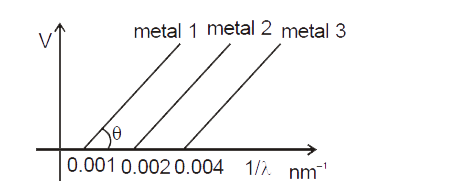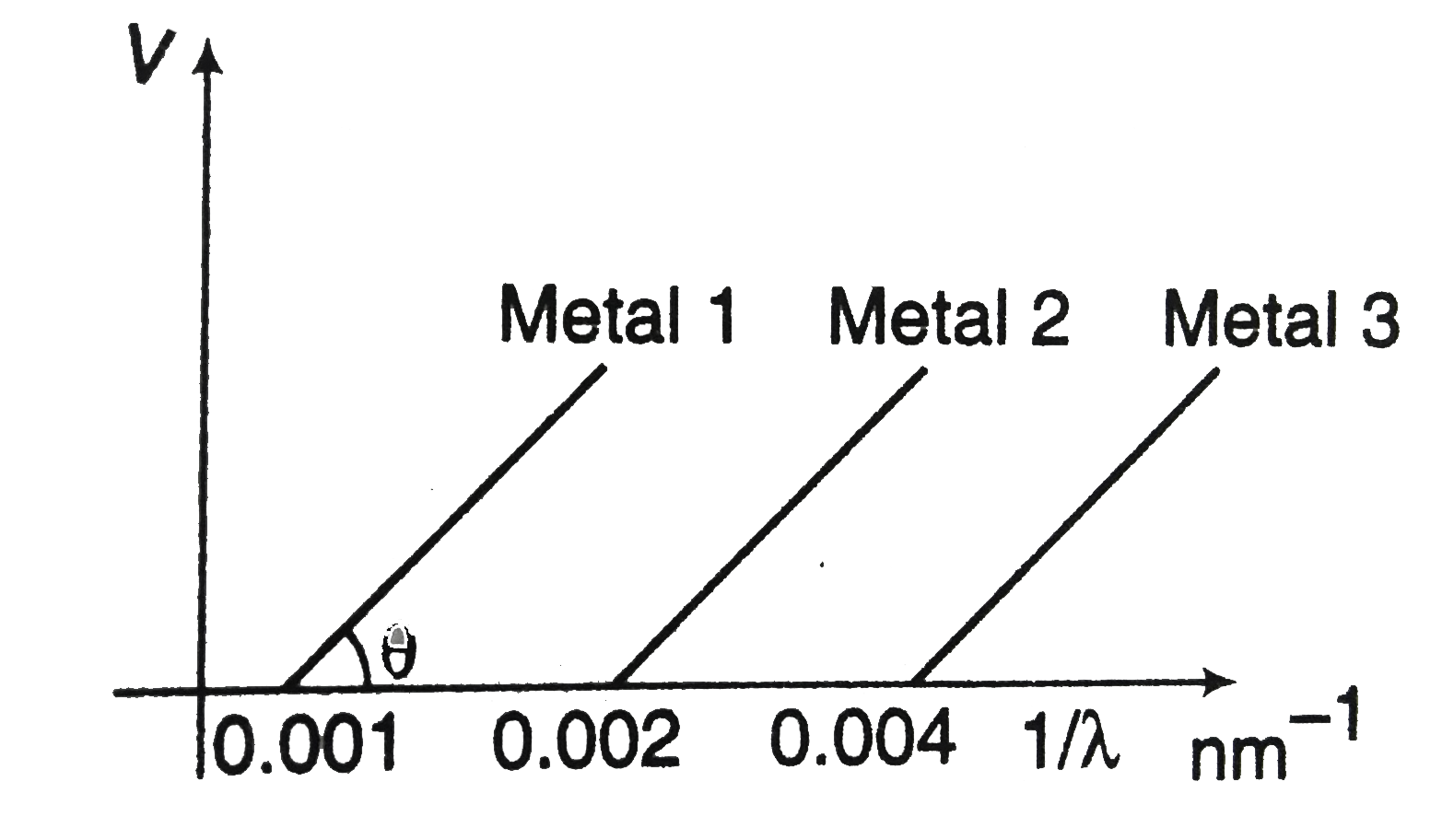A metal is heated up to a certain temperature, the work function changes from photoelectric current before and after change are Keeping all other condition unchanged, the correct relation between
The correct Answer is:B
To solve the problem, we need to analyze the relationship between the work function of a metal and the photoelectric current produced when light shines on it.
1. Understanding Work Function:
The work function (φ) is the minimum energy required to eject an electron from the surface of a metal. In this case, we have two work functions: φ₁ (initial) and φ₂ (final), where φ₁ > φ₂. This means that the work function has decreased when the metal is heated.
Hint: Remember that a lower work function means that it is easier for electrons to be ejected from the metal.
2. Photoelectric Current:
The photoelectric current (I) is directly related to the number of photoelectrons emitted from the metal surface when it is illuminated by light. The current produced is proportional to the number of electrons ejected.
Hint: The photoelectric current increases with an increase in the number of emitted photoelectrons.
3. Effect of Work Function on Photoelectric Current:
When the work function decreases (from φ₁ to φ₂), it becomes easier for electrons to be emitted from the metal. This means that for the same intensity of light, more electrons will be ejected.
Hint: A decrease in work function leads to an increase in the number of emitted electrons, which in turn increases the current.
4. Intensity of Light:
The problem states that all other conditions remain unchanged, including the intensity of the light. The intensity of light is related to the number of photons striking the surface of the metal. Since the intensity is unchanged, the number of photons remains constant.
Hint: The intensity of light affects the number of photons, but since it is constant, we focus on the change in work function.
5. Conclusion on Current Relation:
Since the work function has decreased, the number of photoelectrons emitted will increase, leading to an increase in the photoelectric current. Therefore, we can conclude that the photoelectric current after the change (I₂) will be greater than the photoelectric current before the change (I₁).
However, since the problem asks for the correct relation between I₁ and I₂, we can summarize this as:
- If φ₁ > φ₂, then I₁ < I₂.
Final Relation:
I₂ > I₁
Summary:
The correct relation between the photoelectric currents before and after the change in work function is:
I2>I1
The work function (φ) is the minimum energy required to eject an electron from the surface of a metal. In this case, we have two work functions: φ₁ (initial) and φ₂ (final), where φ₁ > φ₂. This means that the work function has decreased when the metal is heated.
The photoelectric current (I) is directly related to the number of photoelectrons emitted from the metal surface when it is illuminated by light. The current produced is proportional to the number of electrons ejected.
When the work function decreases (from φ₁ to φ₂), it becomes easier for electrons to be emitted from the metal. This means that for the same intensity of light, more electrons will be ejected.
The problem states that all other conditions remain unchanged, including the intensity of the light. The intensity of light is related to the number of photons striking the surface of the metal. Since the intensity is unchanged, the number of photons remains constant.
Since the work function has decreased, the number of photoelectrons emitted will increase, leading to an increase in the photoelectric current. Therefore, we can conclude that the photoelectric current after the change (I₂) will be greater than the photoelectric current before the change (I₁).
- If φ₁ > φ₂, then I₁ < I₂.
I₂ > I₁
The correct relation between the photoelectric currents before and after the change in work function is:
I2>I1
Topper's Solved these Questions
- DUAL NATURE OF RADIATION AND MATTER BOOK - MODERN PUBLICATIONCHAPTER - DUAL NATURE OF RADIATION AND MATTER EXERCISE - COMPETITION FILE (OBJECTIVE TYPE QUESTIONS ( B - Multiple Choice Questions) (AIPMT/NEET & Other State Boards for Medical Entrance))
26 Videos
- DUAL NATURE OF RADIATION AND MATTER BOOK - MODERN PUBLICATIONCHAPTER - DUAL NATURE OF RADIATION AND MATTER EXERCISE - COMPETITION FILE (OBJECTIVE TYPE QUESTIONS ( B - Multiple Choice Questions) (JEE (Main) & Other State Boards for Engineering entrance))
18 Videos
- DUAL NATURE OF RADIATION AND MATTER BOOK - MODERN PUBLICATIONCHAPTER - DUAL NATURE OF RADIATION AND MATTER EXERCISE - Revision Exercises (Numerical Problems)
20 Videos
- CURRENT ELECTRICITYBOOK - MODERN PUBLICATIONCHAPTER - CURRENT ELECTRICITYEXERCISE - Chapter Practice Test
15 Videos
- ELECTRIC CHARGES AND FIELDS BOOK - MODERN PUBLICATIONCHAPTER - ELECTRIC CHARGES AND FIELDS EXERCISE - Chapter Practice Test
15 Videos
Similar Questions
Ultraviolet light is incident on two photosenstive materials having work functions ϕ1 and ϕ2(ϕ1>ϕ2). In which case will the K.E. of the emitted electrons be greater ? Why ?
View SolutionThe graph between 1/λ and stopping potential ( V ) of three metals having work functions ϕ1,ϕ2 and ϕ3 in an experiment of photoelectric effect is plotted as shwon in the figure. Which of the following statement (s) is / are correct ? [Here λ is the wavelength of incident ray ].

View Solution
Knowledge Check
The cathode of a photoelectric cell is changed such that the work function changes from (W1→W2(W2>W1). If the current before and after change are I1 and I2, all other conditions remaining unchanged , then (assuming hv>W2)
AI1=I2BI1<I2CI1>I2DI1<I2<2I1If the electric flux entering and leaving an enclosed surface respectively is ϕ1 and ϕ2 then the electric charge inside the surface will he
A(ϕ+ϕ2)ε0B(ϕ2−ϕ1)ε0C(ϕ1−ϕ2)ε0D(−ϕ1−ϕ2)ε0If the electric flux entering and leaving an enclosed surface are ϕ1andϕ2 respectively, then the electric charge present within the surface is
A1∈0(ϕ1+ϕ2)B1∈0(ϕ2−ϕ1)C∈0(ϕ1+ϕ2)D∈0(ϕ2−ϕ1)
The graph between 1/λ and stopping potential (V) of three metals having work- functions Φ1, Φ2 and Φ3 in an experiment of photoelectric effect is plotted as shown in the figure. Which of the following statement(s) is/are correct? (Here, λ is the wavelength of the incident ray). (a) Ratio of work functions ϕ1:ϕ2:ϕ3=1:2:4 (b) Ratio of work functions ϕ1:ϕ2:ϕ3=4:2:1 (c ) tan θ is directly proportional to hc / e, where h is Planck constant and c is the speed of light (d) The violet colour light can eject photoelectrons from metals 2 and 3 .

View SolutionShow that if the flux of magnetic induction through a coil changes from ϕ1 to ϕ2 then the charge q that flows through the circuit of total resistance R is given by q=ϕ2−ϕ1R where R is the resistance of the coil.
View SolutionThe magnetic flux linked with a coil of N turns and resistance R changes from ϕ1 to ϕ2. Show that the charge that has passed through the coil is
q=−N(ϕ2−ϕ1)R.
View SolutionIf the electric flux entering and leaving an enclosed surface respectively is ϕ1 and ϕ2, the electric charge inside the surface will be
View SolutionIf θ1 and θ2 be the apparent angles of dip observed in two vertical planes at right angles to each other, then the true angle of dip θ is given by
View Solution
